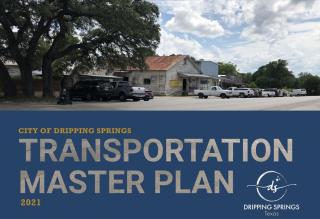City Approves Transportation Master Plan

DRIPPING SPRINGS, TEXAS – Wednesday, October 20, 2021 – At last night’s City Council meeting, Council members approved the City of Dripping Springs Transportation Master Plan. The approval comes after years of extensive meetings and public open houses and includes modifications to address many of the concerns and needs that citizens expressed during the meetings.
The City’s Transportation Master Plan is a long-range planning document that defines goals and policies for its transportation system. It includes recommendations to prepare for future needs of the community. The adopted Transportation Master Plan will:
- Promote safe mobility within the City’s transportation infrastructure
- Develop a future transportation system that accommodates growth
- Establish the ultimate roadway network and identify right-of-way needs to meet future growth
- Identify mobility improvements
Some of the other goals for the Transportation Master Plan include identifying deficiencies in the current transportation network and creating policies to guide developers on the transportation needs within the City.
Per Deputy City Administrator Ginger Faught, “We know that traffic is the number one concern of our current residents. We also know the challenges that growth can bring to our community’s traffic and mobility. While growth is inevitable, we want to do everything we can to support that growth with investments into a transportation infrastructure that meets the needs of our City, both currently and in the future. This Master Transportation Plan provides us with the direction to do just that.”
To help craft the Transportation Master Plan, the City hired HDR Engineering, Inc. to evaluate transportation conditions and develop recommendations. The Transportation Master Plan evaluated traffic operations throughout the City and ETJ and identified needed roadway improvements. An updated traffic study included an operational analysis at over 20 key intersections.
Both short- and long-term traffic improvements were recommended and are included in the Master Plan. Funding and resources are not available to implement all recommended projects immediately. So, projects are prioritized and critical and/or short-term projects are identified. Some of the short-term improvements include:
- Extension of Roger Hanks Parkway
- Connection of a new roadway between RM 12 and US 290 in Northeast Dripping Springs
- Enhancements to Rob Shelton Boulevard
The Master Transportation Plan also looks at long-term traffic needs, looking ahead to growth through the year 2040. Some of the mid- and long-term recommendations include:
- Widening of US 290
- Construction of new North/South connections within Dripping Springs
- Construction of bypass routes around the City
Transportation improvements were assessed based on project scope and the transportation impact to prioritize projects by need and feasibility. Smaller and more critical projects, such as safety improvements to a local roadway, are prioritized for short-term implementation. Projects with large scopes and complex planning requirements or those aimed at addressing future traffic demands are identified for long-term implementation. Projects requiring additional right-of-way, environmental assessments, and partner-agency coordination will occur in the mid- to long-term time periods.
Throughout the process of creating the City’s Transportation Master Plan, two important key factors were at the center of all discussions: first, to continue to embrace the character of Dripping Springs and second, to preserve and enhance the heart of the City, downtown Dripping Springs.
To help with those factors, the thoroughfare plan has prioritized transportation enhancements in areas with existing congestion and prioritized new thoroughfares in areas with imminent growth. As feasibility studies are initiated for new roadways, evaluations of new roadway impact on the community, its character, and the environment will be undertaken.
“Downtown Dripping Springs, the heart of the City, is continuously evolving in land use, and is becoming a greater attraction for residents and visitors alike,” says Mayor Bill Foulds. “With its historic buildings, charming atmosphere, and thriving business environment, it’s a growing destination location in Central Texas. We must make sure that any enhancements and additions to 290 and other road infrastructure protects and maintains the character of downtown Dripping Springs.”
At the council meeting, about a dozen citizens expressed concern over some aspects of the plan, including the impact to their properties and to the environment. Mayor Foulds reiterated that the Transportation Master Plan is a tool to be utilized when future developers work with the City. Per Foulds, “This gives the City more leverage when working with the developers, to ensure they help with connectivity needs and help ease the congestion that could come from their proposed developments. Before any roads are constructed, feasibility and environmental impact studies will be done.”
The Transportation Master Plan was created in close coordination with TxDOT and Hays County, as those agencies also have ongoing transportation studies within the City of Dripping Springs. Working with these agencies helps maintain the consistency in transportation planning and infrastructures improvements and provides a stronger foundation to meet the future transportation needs of the City.
The plan will continuously be updated with the evolving transportation and lifestyle needs of Dripping Springs and will be updated every 5 years to adapt to regional transportation thoroughfare plan updates and the rapid development in the City and its ETJ.
For questions or to see the plan, go to our Transportation Master Plan page.
